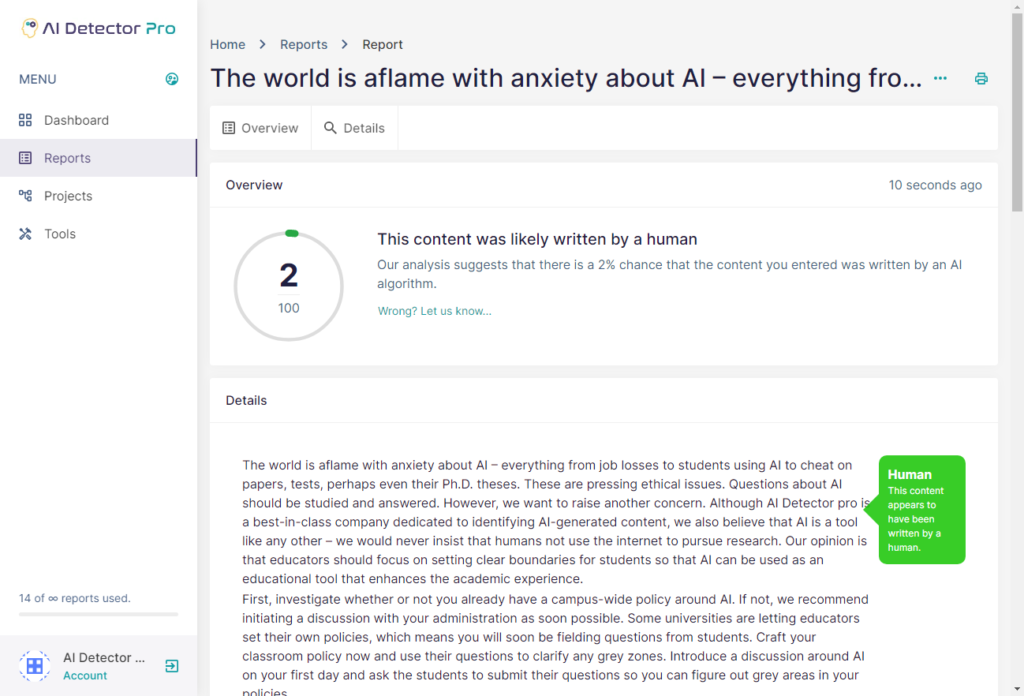The world is aflame with anxiety about AI – everything from job losses to students using AI to cheat on papers, tests, perhaps even their Ph.D. theses. These are pressing ethical issues. Questions about AI should be studied and answered. However, we want to raise another concern. Although AI Detector pro is a best-in-class company dedicated to identifying AI-generated content, we also believe that AI is a tool like any other – we would never insist that humans not use the internet to pursue research. Our opinion is that educators should focus on setting clear boundaries for students so that AI can be used as an educational tool that enhances the academic experience.
First, investigate whether or not you already have a campus-wide policy around AI. If not, we recommend initiating a discussion with your administration as soon possible. Some universities are letting educators set their own policies, which means you will soon be fielding questions from students. Craft your classroom policy now and use their questions to clarify any grey zones. Introduce a discussion around AI on your first day and ask the students to submit their questions so you can figure out grey areas in your policies.
You can even let students know that your AI policy might be progressive and that you will provide them with changes as AI evolves. We assume you have the authority to do this, but this is why you need to figure out your institutional policy as quickly as possible. In general, we strongly recommend that policies around AI not be set in stone. AI tech is evolving so quickly that you should petition your administration for some leeway in modifying your classroom policy and revisit institutional policies at a regular cadence.
Second, never develop a classroom policy around a technology that you have never used. It’s the modern equivalent of saying your students can’t use the internet. We recommend the following 5-point plan for developing a classroom policy.
- Register for and try out ChatGPT: it works on a conversational style so ask it up to 3 questions that you want students to think about for your class. An example of how to talk to ChatGPT is asking it something like “should the British be held accountable for the Bengal Famine of 1943 as the ruling Colonial Power in India” or “should people from the past be held accountable for their racist beliefs?”
- Check out YouTube and search for how to evade AI Detection Tools: we are suggesting this just so you get a flavor of how quickly this technology is evolving. Don’t take it to heart or be discouraged. You are better off prepared and will write a fairer policy if you check this out. Try out the techniques and review the modified content before moving to Step 3.
- Evaluate the content the AI provides you (the first one and the revised content after you try out the techniques to evade detection). Be objective and write down your critique of the content itself. Is it simplistic? Do you want more citations? Do you expect a certain type of analysis to be present in the content? Be objective and don’t focus on the time it took for the AI to generate a response. Always think of ChatGPT as another version of the internet. It exists and will exist from now on so the best thing you can do is work with it in a way you think is fair to yourself and your students from a pedagogical standpoint. If you want your students to respect your policy it shouldn’t seem like it was biased with a “kids these days” attitude.
- Set clear guidelines for using ChatGPT as a tool: can students use it to generate a first draft that they will need to improve upon with more nuanced arguments? Can they use it to fact check their unique content or teach themselves something when they’ve missed class? If you can identify positive points to AI and explain the benefits and downsides to students and how they can utilize it to their benefit, they are more likely to abide by your classroom policy.
- Think about the answers that ChatGPT gave back to you: What additional analysis would you add to it and do you teach these techniques to students in class? Are you even teaching these deeper writing techniques or analytical models right now? You can even use the content you generated from ChatGPT as an example of what you will be looking for and how students will be expected to improve upon basic ChatGPT content.
Third, register and try out AI Detector Pro for free. AI Detector Pro’s free plan lets you have 3 reports of 10,000 characters each. Copy and paste the content you generated from ChatGPT for your classroom policy through AI Detector Pro and read through the report carefully. We flag the type of language that is indicative of AI. We will provide you with a risk score. The more reports you run through AI Detector Pro, the more skilled you will become learning how AI produces content. Don’t forget that your brain is the world’s first computer. If you anticipate heavy use of AI in your classroom, consider our unlimited plan or ask your administration to contact us to discuss an enterprise solution. Bear in mind that we do not currently process more than 10,000 characters.
Fourth, think of AI Detector Pro as more than just an “AI cheating check.” By monitoring your classroom on an ongoing basis you may be able to identify a root cause as to why a student or students are exceeding the limits of your published policy. An AI identifier like AI Detector Pro may help you uncover problems impacting your students and driving their use of AI that might not be immediately visible to you. Your students might be dealing with financial problems or issues at home that could be causing extra tension and driving them to go beyond the bounds of what you have defined as an AI policy.
Fifth, if a student is flagged as having used AI in what you consider beyond your boundaries or institutional policies, take a deep breath. Don’t make assumptions. There are a lot of examples of students being falsely flagged and you don’t want to earn a reputation as a professor that becomes automatically enraged. This is why AI Detector Pro provides you a risk score. Our reports highlight the text we think was produced using an AI. The reports are color coded to allow you to ask students specific questions about what they turned in. Give the student some grace and have a face-to-face conversation before you or your administration fails them for cheating. Students that truly feel falsely accused tend to provide digital evidence to that effect.
Finally, remember that it’s important to keep in mind that technology and standards around technology constantly evolve. We are in the early stages of developing and using AI – at some point it may become as mundane as Wikipedia or encyclopedias. Remember that ChatGPT can’t substitute your professionalism and value, nor can it teach your students how to think. Treat it calmly and challenge yourself to think about its value. Set clear guidelines and policies and your students will use it like a tool. Show actual examples of how AI got an answer wrong (not tripping a detector but just factually wrong). You should be able to find these types of examples on the internet.
Your policies should engage students on how to use a tool that will help rather than hurt their education. Remind them that when they engage in cheating, they only hurt themselves and their careers in the long-run. They won’t be able to pass in-person proctored exams (like the LSAT, GMAT, MCAT or the Bar) . Not taking the time to learn WILL eventually catch up to them and all the tuition they are paying will be wasted. As time passes, examples will be widely publicized and beat back overreliance on AI. Our parting recommendation is that you keep an eye out and become familiar with how to anticipate AI proactively. This means keeping track of AI technologies, the content it produces AND AI detectors. After all, isn’t the point of life to learn and progress?
Here is what AI Detector Pro says about this blog: HUMAN

